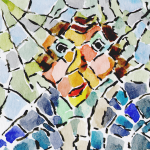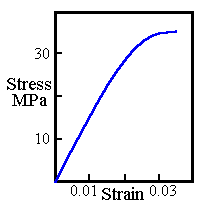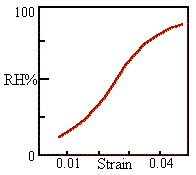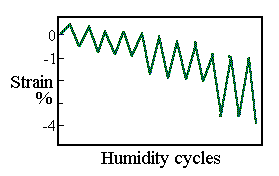
 |
Stress, strain and craquelure - 7 |
Artists' canvas has traditionally been impregnated, or coated, with animal glue. This provides a barrier against penetration of the next layer, which is the ground, usually a mixture of linseed oil and chalk, sometimes mixed with pigment. Linseed oil releases fatty acids as it ages. These would weaken the cellulose fibres of the linen if the oil were allowed to penetrate the canvas. The other purpose of the glue layer is to hold the ground on the surface so that it evens out the hollows and bumps of the fabric structure without penetrating and stiffening the canvas. Glue applied as a thin coating on textiles or paper fibres is called size.
 From this stress-strain diagram for glue (1) we can read that the breaking strain is about 0.03.
From this stress-strain diagram for glue (1) we can read that the breaking strain is about 0.03.
From the diagram below (2) we notice that the strain caused by a 60% change in RH is also about 0.03. Already we have enough information to realise that the stress generated in the glue size layer is an important, even devastating factor in the mechanical behaviour of oil paintings.
The coefficient of thermal expansion of gelatin is about 0.00003 (m/m per degree C). A temperature change of 30 degrees will therefore cause a strain of about 0.001, which is tiny in comparison with the strain caused by change of relative humidity.

This is very much an order of magnitude calculation, designed to alert us to the danger of relative humidity change around oil paintings. The stress-strain diagram is very much affected by RH: gelatin becomes much stiffer at low RH. Another complicating factor is the time dependence of the stress-strain diagram. If gelatin is strained slowly, especially at high RH, it does not develop nearly so high a stress. This stress relaxation saves the painting from the destruction theoretically predicted from these two diagrams.
 Another complication of the behaviour of glue on canvas is the locked-in strain that develops as the glue first becomes stiff by gelling and then dries out. The extra stress caused by the loss of water cannot be relieved by movement, because the glue is already locked in place among the fibres of the canvas. This stress is not even revealed by measurement on free films dried under restraint to imitate application to cloth. The stress is concealed at a molecular level in the stretched protein strands. It only reveals itself when the film is taken to very high RH: over 90%. The gelatin will then shrink as the molecules are lubricated by water and can slip past one another to attain a more congenial position.
Another complication of the behaviour of glue on canvas is the locked-in strain that develops as the glue first becomes stiff by gelling and then dries out. The extra stress caused by the loss of water cannot be relieved by movement, because the glue is already locked in place among the fibres of the canvas. This stress is not even revealed by measurement on free films dried under restraint to imitate application to cloth. The stress is concealed at a molecular level in the stretched protein strands. It only reveals itself when the film is taken to very high RH: over 90%. The gelatin will then shrink as the molecules are lubricated by water and can slip past one another to attain a more congenial position.
This process has been described by Karpowicz (3). The diagram shows the gradual shrinkage (negative strain) of a free gelatin film that had been dried under restraint, corresponding to application to a canvas. As the RH is cycled between 54% and over 90% the gelatin shrinks progressively.
During a change from normal to low RH after a period of cycling between high and normal RH the now shrunken film exerts its normal stress increase with falling relative humidity. Karpowicz made some experiments with brittle paint on canvas that demonstrated that this process produces the typical craquelure, with cracks in arcs centred on the corners of the painting.
1. Zelikman, V.L. and Levi, S.M. Making and coating photographic emulsions, London 1964, p57
2. Mecklenburg, M.F., McCormick-Goodhart, M. and Tumosa, C.S. Investigation into the deterioration of paintings and photographs using computerised modeling of stress development, J. Amer. Inst. Cons. 33 (1994) 153-70.
3. Karpowicz, A., In-plane deformations of films of size on paintings in the glass transition region, Studies in Conservation 34 (1989) 67-74
The time factor in the response of paintings to environmental change

This work is licensed under a Creative Commons Attribution-Noncommercial-No Derivative Works 3.0 License.